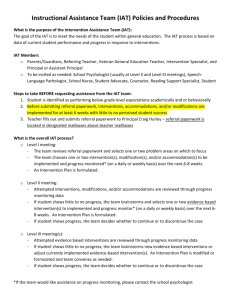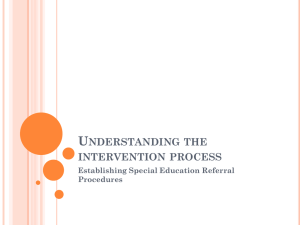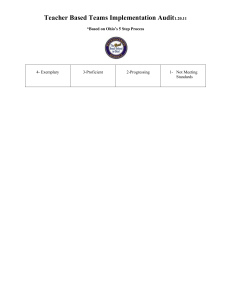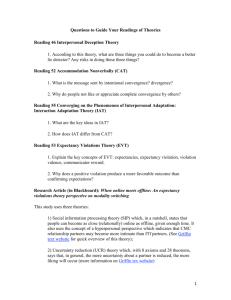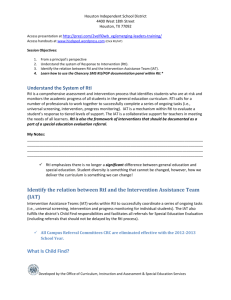International ACH Transactions (IAT) Frequently Asked Questions
advertisement
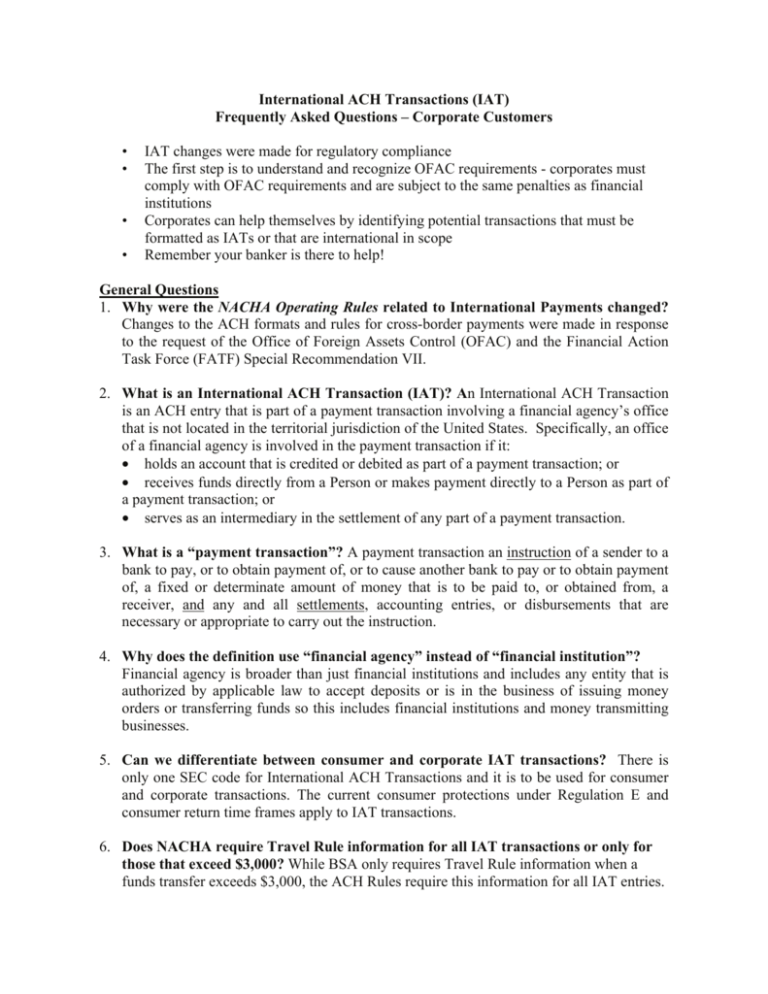
International ACH Transactions (IAT) Frequently Asked Questions – Corporate Customers • • • • IAT changes were made for regulatory compliance The first step is to understand and recognize OFAC requirements - corporates must comply with OFAC requirements and are subject to the same penalties as financial institutions Corporates can help themselves by identifying potential transactions that must be formatted as IATs or that are international in scope Remember your banker is there to help! General Questions 1. Why were the NACHA Operating Rules related to International Payments changed? Changes to the ACH formats and rules for cross-border payments were made in response to the request of the Office of Foreign Assets Control (OFAC) and the Financial Action Task Force (FATF) Special Recommendation VII. 2. What is an International ACH Transaction (IAT)? An International ACH Transaction is an ACH entry that is part of a payment transaction involving a financial agency’s office that is not located in the territorial jurisdiction of the United States. Specifically, an office of a financial agency is involved in the payment transaction if it: • holds an account that is credited or debited as part of a payment transaction; or • receives funds directly from a Person or makes payment directly to a Person as part of a payment transaction; or • serves as an intermediary in the settlement of any part of a payment transaction. 3. What is a “payment transaction”? A payment transaction an instruction of a sender to a bank to pay, or to obtain payment of, or to cause another bank to pay or to obtain payment of, a fixed or determinate amount of money that is to be paid to, or obtained from, a receiver, and any and all settlements, accounting entries, or disbursements that are necessary or appropriate to carry out the instruction. 4. Why does the definition use “financial agency” instead of “financial institution”? Financial agency is broader than just financial institutions and includes any entity that is authorized by applicable law to accept deposits or is in the business of issuing money orders or transferring funds so this includes financial institutions and money transmitting businesses. 5. Can we differentiate between consumer and corporate IAT transactions? There is only one SEC code for International ACH Transactions and it is to be used for consumer and corporate transactions. The current consumer protections under Regulation E and consumer return time frames apply to IAT transactions. 6. Does NACHA require Travel Rule information for all IAT transactions or only for those that exceed $3,000? While BSA only requires Travel Rule information when a funds transfer exceeds $3,000, the ACH Rules require this information for all IAT entries. International ACH Transactions (IAT) Frequently Asked Questions – Corporate Customers, Page 2 7. Which party handles the foreign exchange on an IAT transaction? That decision will be made by the parties to the transaction and is not within the scope of the IAT changes or the NACHA Operating Rules. 8. How do I know if an IAT is inbound or outbound? An inbound IAT means an entry that originates in another country and is transmitted into the United States. An outbound IAT means an entry that originates in the United States and is transmitted to another country. OFAC Responsibilities 9. As a corporate originator/receiver, do I have OFAC responsibilities? ACH Receivers and Originators are subject to U.S. law, including OFAC sanctions. Originating Financial Institutions will obligate an Originating Company or Third Party Sender through the warranties in their ACH origination agreement or terms & conditions. The Originating Company acknowledges that they may not initiate ACH entries that violate the laws of the United States. 10. Who should screen the IAT for OFAC compliance? The IAT should be screened by the Originator prior to sending, by the financial institutions, and by the Federal Reserve (if acting as the Gateway Operator). All parties to the entry have a responsibility to know their customer. 11. What if I ignore my OFAC responsibilities? OFAC violations carry penalties. These can be both criminal and civil and vary by sanctions' program. Penalties can include: imprisonment of the employee (10-30 years depending on the program), fines per count to corporate and individuals ($10,000 - $10,000,000 per count), and forfeiture of property 12. How many true OFAC hits are anticipated to happen in the ACH? Most FIs may never see a true hit, some may see 1-2 per year. FIs can look to their wire area for an idea of what they may see. Canadian FIs will screen against the US OFAC list before sending any entries into the US. 13. What are the contact websites for OFAC? OFAC Homepage: www.treas.gov/ofac OFAC SDN List: http://www.treas.gov/ofac/t11sdn.pdf Recent SDN Changes: http://www.treas.gov/ofac/t11sdnew.pdf Downloadable SDN List: http://www.treas.gov/ofac/t11sdall.exe OFAC FAQs: http://www.ustreas.gov/offices/enforcement/ofac/faq/answer.shtml#24 Revised 1/30/09 International ACH Transactions (IAT) Frequently Asked Questions – Corporate Customers, Page 3 Identifying IATs 14. Where can I find information to help determine if an entry should be coded as an IAT? NACHA developed several potential IAT scenarios with representatives from large global transaction banks. These scenarios are not all inclusive but the scenarios have been reviewed and agreed to by OFAC with regards to the interpretations of the scenarios. This document can be found on NACHA’s IAT Resource Page, in the IAT Survival Guide and in the NACHA Operating Guidelines. 15. If a US Company originates payments that are international but uses the bank’s proprietary system, instead of the US ACH Network, are these payments IAT? If the entries are not sent through the US ACH Network, the entries do not need to be coded as IAT. The Originator is still subject to OFAC requirements and the bank should screen the information for OFAC compliance. 16. My company has our payments processed offshore, but the payments are funded from a bank in the U.S. to accounts in the U.S., should they be coded as IATs? These payments are not IATs. The IAT definition does not apply to transactions involving data received or processed offshore if 1) the processing entity is not a party to the transaction, and 2) the processing does not alter the terms of the transaction, and 3) the offshore party has no direct financial stake in the transaction through an account relationship or settlement obligation. 17. If a US Company originates payments via the US ACH Network to US Receivers, but informs the ODFI that they will be receiving a transfer from a foreign account to fund the payments, is this an IAT? Yes, this would be an IAT. 18. A Payroll Processor has a customer (referred to as Company) that is located outside the territorial jurisdiction of the U.S. All of the employees of this Company are located in the U.S. and the Company has an account at a Financial Institution within the U.S. The Company sends Wire Transfers periodically to deposit money into their U.S. account. These Wire Transfers are not specifically to fund the account for payroll; however, this account is debited by the Payroll Processor for purposes of funding the payroll. Would the transactions originated by the Payroll Processor on behalf of the Company have to be in the IAT format? No, these would be domestic payments. The funding to trigger the definition of the IAT has to be specific to fund the ACH transactions. 19. If the Receiver is located outside of the US that does not necessarily make an entry an IAT, but does it make sense that, to err on the side caution, Originators should create IAT entries for customers not living in the US? Are there any penalties for sending IAT transactions when the entry should be domestic? NACHA has had organizations indicate they will follow that course and there is no penalty with this concept. To make a clearer determination if the entry should be IAT Revised 1/30/09 International ACH Transactions (IAT) Frequently Asked Questions – Corporate Customers, Page 4 or domestic, the Originator would need to contact all Receivers with foreign addresses to determine if the funding will be leaving the US or remaining in a bank account in the US. 20. How will the Originator or ODFI identify that funding for ACH transactions came in from a foreign financial institution? Often a wire may be processed through a correspondent bank and looks as though it was originated domestically. The Originator and ODFI need to discuss the funding of transactions. This is an education and training issue that should be addressed with all customers. 21. Does Scenario F apply to pension/SSA payments only, or would it apply to other similarly structured payments for B2C or B2B? As an example, suppose a client receives interest payments to its US-domiciled account. There is a standing instruction to send these interest payments to another beneficiary (a son, daughter at school, for example), who has a non-US-domiciled account. Should the original interest payment to the client’s US-domiciled account be treated as an IAT? If the Originator knows the funds will be leaving the country, it should be coded as an IAT. 22. How does the ODFI know the funds will ultimately move international? It is the responsibility of the ODFI to educate their Originators and the responsibility of the Originators to review their client files to determine if IAT might be needed. One clue to watch for would be foreign addresses in Receiver’s customer files. In that example, the Originator should contact the Receiver. Some Originators will choose to be cautious and use IAT when they suspect the funds will move internationally. ODFIs must do their due diligence with their customers to communicate and educate on IAT. ODFIs must have proper agreements with their Originators that address this. 23. For Companies/ACH Originators that offer payroll cards to employees that do not have a U.S. bank account and primarily use the card outside the U.S. territory and the payroll card is funded via an ACH file, will the payroll card funding need to be originated as an IAT? It will depend on where the account is held that serves for the payroll card. If the funding only moves within the US, even though the cards are used internationally, the funding for the payroll card would be domestic. If the funding for the payroll card was received from outside the US, then the funding would be done as an IAT. Operational 24. What additional information do I need to provide for an IAT entry? The new IAT format has added the following mandatory fields to carry the information needed for a regulatory review: Receiver’s Account Number, Receiver’s DFI Identification Number, Payment Amount, Reason for Payment, Receiver’s Name, Receiver’s Street Address (not P.O. Box), Receiver’s City, State or Province, and Postal Code, Originator’s Name and Identification Number, Originator’s Street Address (not P.O. Box), Originator’s City, State or Province, and Postal Code, ISO destination country code country code (or at least destination country), Receiving bank (name, Revised 1/30/09 International ACH Transactions (IAT) Frequently Asked Questions – Corporate Customers, Page 5 identification, qualifier, branch country code), Amount of entry and FX arrangements, and Transaction type code (reason for payment). 25. Is remittance information available with an IAT transaction? Two optional addenda records accommodate the transmission of remittance information. A maximum of 160 characters (80 characters per addenda record) may be included. 26. Can an IAT pre-note be initiated? Yes. An IAT pre-notification entry must include the seven mandatory addenda records and be screened for OFAC compliance. While the use of the pre-note is supported with the IAT, please be aware that the concept of pre-notes is not supported in most countries around the world and in most cases you will not receive a response to your pre-note. 27. Can an IAT be reversed? Can an NOC be sent for an IAT? Returns, prenotes, and NOCs are supported by the ACH Network and are permitted under the NACHA Operating Rules. Generally, however, these processes do not have counterparts within other countries. Although it is possible, from an operational perspective, to transmit these types of payments with respect to Outbound IAT Entries, they would be processed only on a best-effort basis and there is no guarantee that the information would be conveyed to or from parties across the border. 28. Can my bank return these transactions? The IAT can be returned for specific reasons outlined in the ACH Rules, but it cannot be returned or rejected solely because the RDFI does not want to process IAT entries. 29. Could the conversion amount change in the return? For an item originated in the U.S. and sent to a receiver in another country and currency, if the item is returned to the U.S. the transaction would be converted back to U.S. dollars and the amount of the transaction may be different than the amount of the original entry. 30. Can I request a copy of the IAT authorization? Yes, but the authorization requirements will vary by originating country as will the response time and the timeframe requirement as with U.S. domestic transactions does not apply. 31. What are the return timeframes for incoming IAT entries? The return timeframes have not changed for IAT processing under the NACHA Operating Rules. 32. What are the return timeframes for outgoing IAT entries? The return timeframe for outgoing IAT entries is determined by the receiving country and will vary by country. 33. With an IAT entry, there will be 7 Mandatory Addenda Records and could be up to 5 Correspondent Bank Addenda so that would reach the 12 maximum addenda records allowed. If the Transaction Type Code was that of an E-Check application which requires the check information in the remittance addenda record, would the first correspondent bank addenda record be dropped? OFAC Revised 1/30/09 International ACH Transactions (IAT) Frequently Asked Questions – Corporate Customers, Page 6 has said they do not want addenda dropped. With the revision of Correspondent Bank to Foreign Correspondent Bank we do not believe this situation will occur. If you do have multiple Foreign Correspondent Banks to add to the record use the first addenda record for the e-Check remittance information and then add up to 4 Foreign Correspondent Banks starting with the first Foreign Correspondent that received the item from the Originating Bank. 34. Some corporates, including state and local governments, request that no ACH debit activity be allowed to post to specific accounts, so their bank automatically returns any ACH debits to these accounts as unauthorized. Would the bank be required to post violating IAT debits to these accounts? OFAC has indicated that they would like to deal with unauthorized debit transactions on a case by case basis. So, if the bank receives an OFAC-violating IAT debit to an account with a debit block, it will need to contact OFAC directly to see how they want the debit handled. 35. A number of Financial Institutions have developed proprietary cross-border CTX solutions with foreign financial institutions, where the delivery of the addenda information in the multiple addenda records provides significant value to the Receiver. Under the assumption that these transactions must be processed as IATs, the limitation on the addenda records materially devalues the benefits of the CTX. a. Question: Is there a NACHA-recommended solution to accommodate the multiple addenda records currently with CTX origination that will not be able to fit into an IAT entry? Is or would NACHA considering the expansion of IAT to include additional Addenda records to accommodate the existing EDI traffic? NACHA is not considering the expansion of the IAT at this time. If market demand is sufficient it may be considered at a later date. The question of remittance information was included in the IAT Request for Comment and the responses indicated that, if the additional remittance information had to be reviewed for OFAC compliance, the industry did not want more than 160 characters of remittance information. b. Question: The only option through the ACH Network appears to be a zerodollar CTX and the monetary portion flowing as the IAT credit. As long as both entries were OFAC screened, could this be a NACHA endorsed solution? The proposed solution to the lack of remittance information in the IAT is an excellent suggestion. It would be helpful if there was a re-association identifier included in both the zero-dollar CTX and the monetary IAT. 36. Is the type 7 record, field 3 Transaction Type Code, what has been referred to as the “secondary SEC code?” If so, is there a reason why the SEC codes PPD and CCD are not included in the rules? The secondary SEC code in the Transaction Type Code field is to identify SEC codes that have additional rule requirements or may carry additional remittance information that must be provided to the consumer. There are no such requirements for PPD or CCD transactions. 37. Is there an official list to reference for field Branch Country Code (Type 713, field 8), ISO destination country (Type 5, field 7), ISO Currency Codes (Type 5, Revised 1/30/09 International ACH Transactions (IAT) Frequently Asked Questions – Corporate Customers, Page 7 Fields 11, and 12)? The official list of ISO Currency and Country codes can be purchased at iso.org. These lists are maintained by the International Organization for Standardization. 38. It seems that inbound IATs with secondary SECs will require additional information in the Remittance Information addenda that will need to be provided on the statements. Is that correct? Some secondary SEC Codes (ARC, BOC, POP, etc) require additional information to be included related to the payment. If remittance information is provided for certain secondary SEC codes this information is required by Regulation E to be provided to the consumers. Revised 1/30/09
